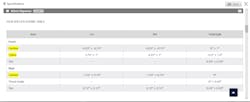Vehicle affected: Any
Tools used:
Scan tool
Vehicle information
Alignment machine
Tire pressure gauge
Tire balancer
Tie rod separator
Thermal imager
You’ve probably heard it before – a customer comes into the shop complaining about a pull or drift to one side. The best place to start determining the cause of this problem is just like most others, asking the customer what the symptoms are, when it happens, and where the problem occurs. Alignment, steering, and suspension issues are common among drivers. With the right procedures, training, and tools in place, these repairs can yield a solid return on investment … as well as satisfied return customers.
With the “pull” scenario above, begin by asking questions like: “What is the direction of the pull?” “Is the pull consistent or intermittent?” “Does the pull occur on any road or at any speed?” “Is the steering wheel straight?”
The answer to each of these questions will not only give you enough information to duplicate the issue, but they may even assist in the diagnosis of the problem. For example, if the customer states the vehicle pulls left, does that mean the vehicle is actually pulling to the left or is the steering wheel just off-set to the left and not centered? If the wheel is just off-set to the left and the vehicle is not pulling in that direction, the issue could be corrected by a simple toe adjustment to re-center the steering wheel.
If the vehicle is pulling and the driver is physically steering to the left to stay in the lane, potential causes could be a mechanical steering or suspension issue, a problem with the brakes or ABS, or even a calibration issue within the ADAS system. At this time, it is usually prudent to check for any technical service bulletins related to brake, steering, or suspension components. We will discuss some of these potential causes, as well as some of the tools you would use to diagnose and repair the vehicle.
Issue 1: Vehicle steers left or right when the wheel is straight
In cases like these, a test drive to confirm the issue is required. During the test drive, be sure to note if any warning lights for the ABS, traction control, or stability control systems are illuminated. If so, scan those systems to determine if there is a fault that could be causing the pulling issue.
After a test drive, it is necessary to thoroughly inspect the steering and suspension components. Do not overlook basic inspection items like tire pressures. Inspect the tires themselves to see if they show signs of a separated cord. Even though it only happens occasionally, don’t forget to double-check to see if the tires are all the same size and similar tread patterns.
If you suspect a tire is the cause of the pull, you could try to rotate the tires or use a tool like the Road Force Balancer from Hunter to see if that takes care of the issue. This wheel/tire balancer measures lateral force, which indicates the “pull value” and the direction of pull in a tire. Understanding any imbalances in tire construction and compensating by either placing weights in precisely the correct spot or matching tires in place on the vehicle where laterally pulling forces oppose each other can eliminate directional pulls.
Always perform a thorough undercar inspection that includes looking for worn or damaged steering or suspension components. It is also a good idea to look at frame rails or unibody pinch points to locate any damage or evidence of clamps used in straightening the frame. If the vehicle was in a collision, straightening the frame can cause some pulling problems. Adjustments may need to be made to the alignment that will allow it to track straight but are not within the posted vehicle specifications.
Some common mechanical issues that go beyond visibly worn components could include faulty bushings or bearings in strut plates or ball joints that do not move freely. To check either of these, use a proper tie rod separation tool, such as the OTC 315A Tie Rod Separator, to disconnect a tie rod end. After disconnecting, if one side turns much harder than the other, it is typically due to the strut plate bearings or bushing, or faulty upper or lower ball joint on the side that turns with more effort.
Brake problems can cause pulls. If there were no faults detected in the ABS, the best tool to determine if a brake is sticking and causing a pull to one side is a diagnostic thermal imager. I prefer a thermal imager to an infrared thermometer in these instances because an imager provides a much clearer picture of the excess heat caused by a tight brake. With an infrared thermometer, you must aim it at the hottest spot in order to determine the value, and it may not be as accurate.
Keep in mind if the vehicle has been driven for quite some time when you are checking the temperature of the brakes, the temperatures may be somewhat high on both sides of the vehicle. In those cases, I would suggest that you let the vehicle cool down for an hour or so. Make sure temperatures are consistent on both sides of the vehicle, then drive it five to ten miles. Use the thermal imager to check to see if one brake is hotter than the other. If so, the brake caliper could be sticking on the hotter wheel, causing a pull to that side.
Issue 2: Vehicle steers left or right after alignment
Even after an alignment, some vehicles can veer to one side or the other. When this occurs, you must check all the items mentioned in the prior section, which include looking for worn tires or steering and suspension components.
Many times, a pull after an alignment is caused by an error on the technicians’ part, either in the set-up of the vehicle or the calibration of the alignment machine. This can be prevented by training your technicians on the proper way to use your alignment equipment and how to prepare the vehicle.
One thing that is easily overlooked while setting up the vehicle is making sure that the load within the vehicle (passenger and trunk compartments) is correct. If there is an excess load in the vehicle, the suspension load will not be appropriate for the alignment specification. In essence, a loaded vehicle can change the ride height, which can change the geometry of the suspension and affect where the caster or camber must be adjusted to eliminate a pull. I have heard of large drivers having an issue with a vehicle pulling, but smaller drivers not experiencing the problem. In these instances, try aligning the vehicle with someone in the vehicle.
Use your vehicle information database to make sure the vehicle is both prepared properly for the alignment and the OEM specifications in the alignment machine specifications agree. In some cases, the data available in the information source will provide different tire size options. The vehicle repair information database will also include information about the calibrations, or resets, you will need to perform. Also noted are the tools and procedures required to perform the resets.
Kaleb Silver, the director of product management at Hunter Engineering, states that 70 percent of vehicles manufactured after 2012 require some type of a reset during or after the alignment process. If these are not completed properly, the vehicle alignment is not complete and can result in a pull, tire wear, or issues with ADAS or other safety systems. Don’t forget – if the vehicle has electronic power steering, a re-calibration of that system along with others will be required after an alignment. The use of a scan tool, or a dedicated tool to be used in conjunction with an aligner, is required for most resets.
Another problem that can occur after aligning is again related to technician training. Many alignment machines have step-by-step directions on how to adjust the vehicle to meet alignment specifications. The machine will list the digital value. In some cases, the specifications are shown as green/yellow/red, indicating if the measurement is in or out of parameters. These machines are great and fast, but without teaching a technician what to do if the vehicle is within specifications but still has an issue, problems can occur.
Another thing to keep in mind is that some newer vehicles have opened up their specifications over the past few years. The tolerances between a value being within the limits are now greater than they once were on many vehicles. For instance, if the camber specification was 1.5-2.5 degrees and the left side was adjusted to 1.5 degrees, and the right was at 2.5degrees (both sides within limits) the variance of one degree would likely cause a pull to the right.
According to Oscar Ferreyra from The Bear Outlet, Innova Corp., problems with slip plates on alignments are a somewhat common cause of pulling issues. If the rear slip plates are worn or rusted, the suspension is not unloaded properly; when the technician makes adjustments, the values represented on the machine are not accurate to the vehicle. Replacing the slip plates with turntables can eliminate this issue.
Alignments were once accomplished with handheld gauges to measure the vehicle and the tools required to adjust the vehicle. Even though those same tools could be used today on some vehicles with varying degrees of success, they would need to be used by a very good alignment technician. The electronic systems in use on vehicles today require a technician to interact with the vehicle to assure every system is working within its parameters and is calibrated correctly. With almost every vehicle requiring a four-wheel alignment, a late model machine is necessary.
Even some alignment machines that are only a generation or two old are not as efficient or accurate as some of the newest technology. Purchasing a late-model aligner could provide a very quick ROI. If you are considering a new aligner purchase, calculate the ROI on the equipment, but don’t forget to include the cost of training your technicians and the potential increased sales of steering and suspension components – typically one of the highest profit centers in a shop.
About the Author

Barry Hoyland
Barry Hoyland has been in the independent aftermarket for more than 45 years as a technician, technician instructor, shop owner, and shop management consultant. He owned and operated a successful Southern California automotive repair center that offers complete auto care and specialized in emission and diagnostic services for over 28 years. Hoyland also owned a company that modified vehicles to perform as emergency response units and mobile command centers, incorporating high-end electronic components into today’s vehicles. Hoyland has experience with all size and types of vehicles including traditional gas, hybrid electric, alternative fuel, and heavy duty diesel trucks.
Hoyland has provided consulting services for many automotive shops, fleets, and government agencies in order to improve their operational efficiencies.
In addition, he has worked with many NHRA drag racing teams as a crew chief on supercharged alcohol and nitro-methane fueled cars and currently serves as a crew chief on a Top Alcohol Funny Car, a Nostalgia Funny Car, and a Nostalgia Alcohol Dragster
Hoyland holds certifications in ASE: A1, A6, A8, and L1, MACS 609, maintains a California Advanced Emission license, and a CDL with endorsements for double and triple trailers, tankers, and HazMat.
When he is not helping to run a shop in the Pacific Northwest, Hoyland travels across the U.S. as an instructor of technical and shop management courses, many of which he has developed.
